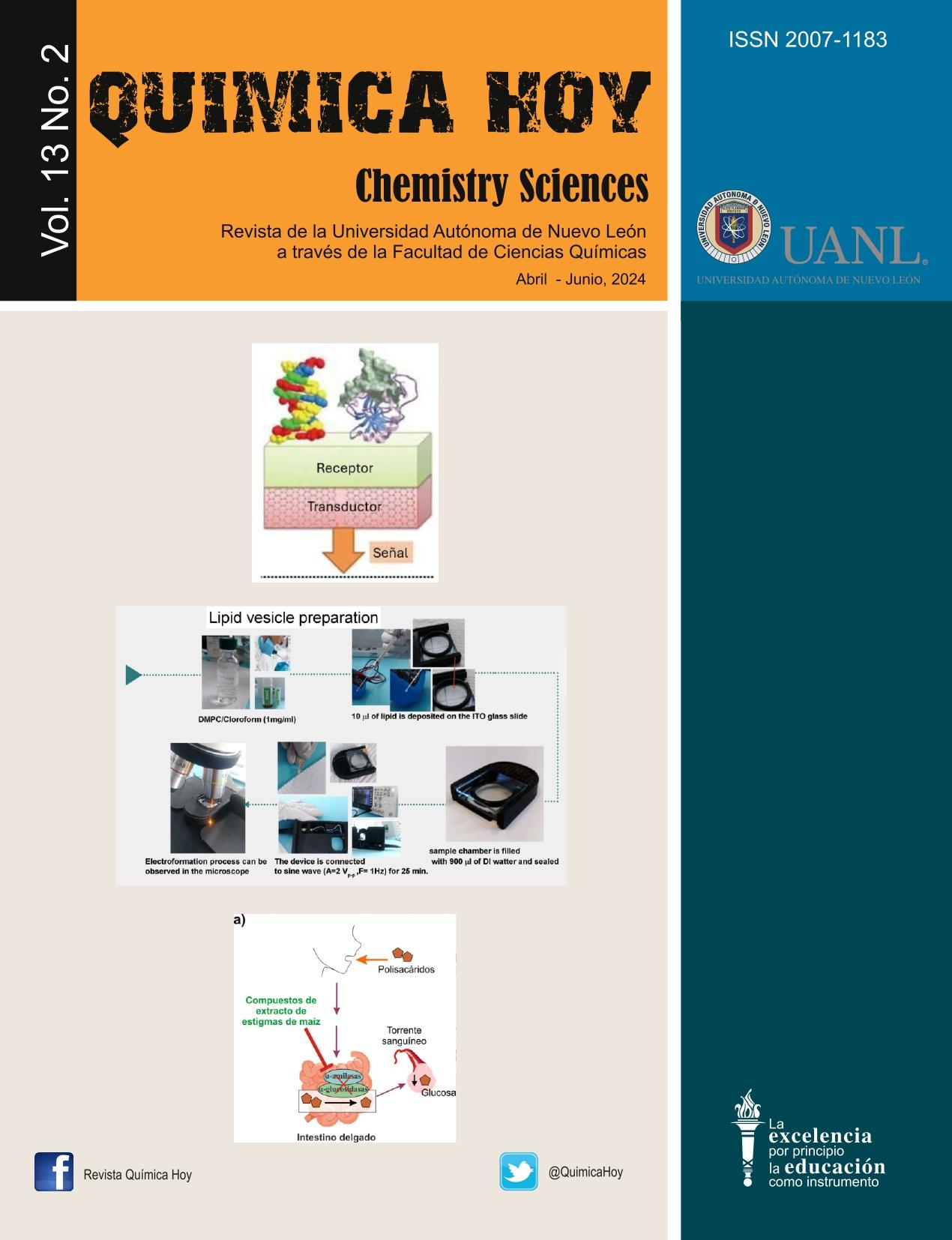Del desecho agrícola a la farmacia: potencial terapéutico del estigma de maíz para el tratamiento de diabetes
DOI:
https://doi.org/10.29105/qh13.02-414Palabras clave:
Estigmas de maíz, desecho agrícola, actividad antidiabéticaResumen
En México, el maíz es un elemento fundamental en la dieta diaria formando parte de una gran variedad de alimentos tradicionales en el país. La tendencia en la producción de este cereal indica que, junto con el arroz, son los de mayor producción a nivel mundial, y México forma parte de los principales productores de este cereal. No obstante, el grano, hojas y silaje de maíz son mayormente aprovechados en la industria alimentaria y ganadera, pero el estigma de maíz es considerado desecho agrícola. Por otra parte, se ha observado que estos estigmas presentan actividad biológica, tales como actividad antidiabética. Por consiguiente, esta revisión presenta los avances actuales sobre el potencial terapéutico del estigma del maíz en el tratamiento parala diabetes tipo 2 y mecanismos de acción.
Descargas
Citas
- [1]. Garcia-Lara, S., & Serna-Saldivar, S.O. (2019). Corn History and Culture. Corn (3" ed.). AACC International Press. https://doi.org/10.1016/B978-0-12-811971-6.00001-2 DOI: https://doi.org/10.1016/B978-0-12-811971-6.00001-2
- [2]. Kaur, P., Singh, J., Kaur, M., Rasane, P., Kaur, S., Kaur, J., Nanda, V., Mehta, C.M., & Sowdhanya, D. (2023). Corn Silk as an Agricultural Waste: A Comprehensive Review on Its Nutritional Composition and Bioactive Potential. Wo. ste Biomass Valorization, 14, 1413-1432. https://doi.org/10.1007/s12649-022-02016-0 DOI: https://doi.org/10.1007/s12649-022-02016-0
- [3]. Vela, E. El Maíz Mexicano En La Historia. (2021). Arqueologia Mexicana, 34-53.
- [4]. Guo, J., Liu, T., Han, L., & Liu, Y. (2009). The Effects of Corn Silk on Glycaemic Metabolism. Nutrition & Metaholi.Eni, 6, 47. https://doi.org/10.1186/1743-7075-6-47 DOI: https://doi.org/10.1186/1743-7075-6-47
- [5]. Nkono,B.L.N.Y., Ablassé, R., Nzikoué, S., Kédi, L.M.,Noa, P.Y.A., Dzeufiet, P.D.D., Sokeng, S.D., & Kamtehouing, P. (2022). Hypoglycemic and Antihyperlipidemic Effects of Hydroalcoholic Extract of Maize Silk on DexamethasoneInduced-Hyperglyeemic Rats. Journal of Cardio-diabetes and metabolic disorders, 2, 15-22. https://dot.org/10.2174/1871530320666200606224708 DOI: https://doi.org/10.4103/JCDM.JCDM_16_21
- [6]. Liang, H.,Zhang,R.,Zhou, L., Wu, X., Chen,J., Li, X., Chen, J., Shan, L., & Wang, H.(2024). Corn Stigma Ameliorates Hyperglyeemia in Zebrafish and GK RatsofType2 Diabetes. Journal o[ Ethnopharmacology, 325, 117746. https://dot.org/10.1016/j.jep.2024.117746 DOI: https://doi.org/10.1016/j.jep.2024.117746
- [7]. Oyabambi, A.O., Michael, O.S., Imam-Fulani, A.O., Babatunde, S.S., Oni, K.T.,& Sanni, D.O. (2021). Corn Silk (Stigma Maydis) Aqueous Extract Attenuates High-Salt Induced Glucose Dysregulation and Cardiac Dyslipidemia: Involvement of Phosphoinositide 3-Kinase Activities. Journal ofA[rican Association ofPhysiological Scíences, 9, 105-112.
- [8]. Shahzad, M.K., Shahzad, M.A., Qadeer, U.,& Mehmood, A. (2022). Investigation of Phytochemical Profiling and Therapeutic Effects of Com Silk against Diabetes in Human Male Subjects. Pakistan Journal of Pharnlaceutical Science.s, 35.
- [9]. Sabiu, S., O'neill, F.H., & Ashafa, A.O.T. (2016). Kineties of α-Amylase and α-Glucosidase Inhibitory Potential of Zea Mays Linnaeus (Poaceae), Stigma Maydis Aqueous Extraet: An in Vitro Assessment.Journal of Ethnopharmacology, 183, 1-8. https://doi.org/10.l016/j.jep.2016.02.024 DOI: https://doi.org/10.1016/j.jep.2016.02.024
- [10]. Zhang, Y.,Pang, J., Yao,L., Wang, C.,Chen,B.,Zheng, Q., Hu, Y., & Qiao, Y. A. (2024). Comparison of Chemical Composition, Bioactive Components and Hypoglycemic Activity of Stigma Maydis Obtained from Different Growing Times. Cogent Food & Agriculture, 10, 2338650, https://doi.org/10.1080/23311932.2024.2338650 DOI: https://doi.org/10.1080/23311932.2024.2338650
- [11]. Alvarado-Díaz, C.S., Gutiérrez-Méndez, N., Mendoza López, M.L., Rodríguez-Rodríguez, M.Z., Quintero-Ramos, A., Landeros-Martínez, L.L., Rodríguez-Valdez, L.M., Rodríguez-Figueroa, J.C., Pérez-Vega, S., & Salmeron Ochoa, I. (2019). Inhibitory Effect of Saccharides and Phenolic Compounds from Maize Silks on Intestinal α-Glucosidases. Journal of Food Biochemistry, 43, 12896. https://doi.org/10.1111/jfbc.12896 DOI: https://doi.org/10.1111/jfbc.12896
- [12]. Wang, J., Zhou, W., Huang, X.,& Song, S. (2023). Flavonoids with Antioxidant and Tyrosinase Inhibitory Activity from Com Silk (Stigma Maydis). Natural Product Re.search, 37, 835-839. https://doi.org/10.1080/14756419.2022.2089986 DOI: https://doi.org/10.1080/14786419.2022.2089986
- [13]. Singh, J., Rasane, P., Nanda, V.,& Kaur, S. (2023). Bioactive Compounds of Corn Silk and Their Role in Management of Glycaemic Response. Journal of Food Science and Technology, 60, 1695-1710. https://doi.org/10.1007/s13197-022-05442-z DOI: https://doi.org/10.1007/s13197-022-05442-z
Descargas
Publicado
Cómo citar
Número
Sección
Licencia
Derechos de autor 2024 Luz María Rodríguez Valdez, Mara Ibeth Campos Almazán, Raúl Rodolfo Flores Mena, Linda Lucila Landeros Martínez, Nora Aydeé Sánchez Bojorge

Esta obra está bajo una licencia internacional Creative Commons Atribución 4.0.





